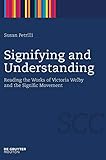Signifying and Understanding : Reading the Works of Victoria Welby and the Signific Movement / Susan Petrilli.
Material type: TextSeries: Semiotics, Communication and Cognition [SCC] ; 2Publisher: Berlin ; Boston : De Gruyter Mouton, [2009]Copyright date: ©2009Description: 1 online resource (1048 p.)Content type:
TextSeries: Semiotics, Communication and Cognition [SCC] ; 2Publisher: Berlin ; Boston : De Gruyter Mouton, [2009]Copyright date: ©2009Description: 1 online resource (1048 p.)Content type: - 9783110218503
- 9783110218510
- 302.2 22/ger
- P99 .P4689 2009eb
- online - DeGruyter
- Issued also in print.
| Item type | Current library | Call number | URL | Status | Notes | Barcode | |
|---|---|---|---|---|---|---|---|
 eBook
eBook
|
Biblioteca "Angelicum" Pont. Univ. S.Tommaso d'Aquino Nuvola online | online - DeGruyter (Browse shelf(Opens below)) | Online access | Not for loan (Accesso limitato) | Accesso per gli utenti autorizzati / Access for authorized users | (dgr)9783110218510 |
Browsing Biblioteca "Angelicum" Pont. Univ. S.Tommaso d'Aquino shelves, Shelving location: Nuvola online Close shelf browser (Hides shelf browser)

|

|

|

|

|

|

|
||
| online - DeGruyter Loanwords in the World's Languages : A Comparative Handbook / | online - DeGruyter Culture and Explosion / | online - DeGruyter Non-Lexical Pragmatics : Time, Causality and Logical Words / | online - DeGruyter Signifying and Understanding : Reading the Works of Victoria Welby and the Signific Movement / | online - DeGruyter Word Frequency Studies / | online - DeGruyter Pragmatic Competence / | online - DeGruyter Strength Relations in Phonology / |
Frontmatter -- Contents -- Introduction -- Chapter 1 -- Welby’s intellectual development and writings -- The texts -- Chapter 2 -- Moving towards What is Meaning? (1903) -- The texts -- Chapter 3 -- A theory of meaning. Significs -- The texts -- Chapter 4 -- Modelling signifying processes. Imagery, critique of language, education and temporality -- The texts -- Chapter 5 -- Translation and meaning from a significal perspective -- The texts -- Chapter 6 -- Mother-sense and subjectivity -- The texts -- Chapter 7 -- Welby’s influence. Theories and movements -- The texts -- Chapter 8 -- Review of the literature. Writings on Welby and significs -- The texts -- Backmatter
restricted access online access with authorization star
http://purl.org/coar/access_right/c_16ec
The theory of signifying (significs), formulated and introduced by Victoria Welby for the first time in 1890s, is at the basis of much of twentieth-century linguistics, as well as in other language and communication sciences such as sociolinguistics, psycholinguistics, translation theory and semiotics. Indirectly, the origins of approaches, methods and categories elaborated by analytical philosophy, Wittgenstein himself, Anglo-American speech act theory, and pragmatics are largely found with Victoria Lady Welby. Indeed, it is no exaggeration to say, in addition, that Welby is the "founding mother" of semiotics. Some of Peirce's most innovative writings - for example, those on existential graphs - are effectively letters to Lady Welby. She was an esteemed correspondent of scholars such as Bertrand Russell, Charles K. Ogden, Herbert G. Wells, Ferdinand S. C. Schiller, Michel Bréal, André Lalande, the brothers Henry and William James, and Peirce, as well as Frederik van Eeden, Mary Everst Boole, Ferdinand Tönnies, and Giovanni Vailati. Her writings directly inspired the Signific Movement in the Netherlands, important for psycholinguistics, linguistics and semantics and inaugurated by van Eeden and developed by such authors as Gerrit Mannoury. This volume, containing introductions and commentaries, presents a selection from Welby's published and unpublished writings delineating the whole course of her research through to developments with the Significs Movement in the Netherlands and still other ramifications, contemporary and subsequent to her. A selection of essays by first-generation significians contributing to the Signific Movement in the Netherlands completes the collection, testifying to the progress of significs after Welby and even independently from her. This volume contributes to the reconstruction on both the historical and theoretical levels of an important period in the history of ideas. The aim of the volume is to convey a sense of the theoretical topicality of significs and its developments, especially in semiotics, and in particular its thematization of the question of values and the connection with signs, meaning, and understanding, therefore with human verbal and nonverbal behavior, language and communication.
Issued also in print.
Mode of access: Internet via World Wide Web.
In English.
Description based on online resource; title from PDF title page (publisher's Web site, viewed 28. Feb 2023)


